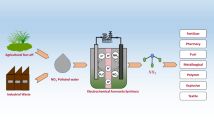Abstract
Experimental results are presented for the electrolytic ChemDen (Chemical-Denitrification) process which was designed to investigate the effect of operational parameters on the nitrate (NO −3 ) removal from metal-finishing wastewater. The parameters included electrode materials, electrode gap, reducing agent, hydraulic retention time (HRT) and recycle ratio in the single electrolytic ChemDen reactor for lab-scale tests. The removal efficiency of nitrate is based upon a non-biological process which consists of chemical and electrolytic treatment. Results showed that removal efficiency of nitrate was highest when the zinc (Zn) electrodes were used for both anode and cathode. In the case of insoluble electrode, combining Pt anode with Ti cathode provided great improvement of nitrate removal. For the Pt-Ti electrode combination, increasing electrode gap tended to increase removal efficiency of nitrate significantly. However, no further increase in the nitrate removal was observed when the electrode gap was longer than 10mm. Using sulfamic acid and Zn metal powder as reducing agents for the electrolytic ChemDen reaction, highest nitrate removal was achieved when the mole ratio of Zn: sulfamic acid: nitrate was 1.2: 1: 1. Remarkable improvement in the nitrate removal was also observed with increasing HRT from 10 to 30 min, while the effectiveness was limited when HRT was increased to 60 min. Recycling in electrolytic ChemDen reactor affected nitrate removal positively because it could improve both dispersion and reuse of Zn metal powder as reducing agent in the reactor. Recycling effects were thought to be associated with increasing surface reactivity of the Zn metal powder in the electrolytic ChemDen reactor.
Similar content being viewed by others
References
K.G. Song, K. H. Ahn, H.Y. Cha, E. S. Park and I.T. Yeom, Korean Society of Environmental Engineers, 20, 593 (1998).
P. Fornari and C. Abbruzzese, Hydrometallurgy, 52, 209 (1999).
S. Ghafaria, M. Hasana and M. K. Aroua, Bioresour. Technol., 99, 3965 (2008).
N. F. Gray, Drinking Water Quality, John Wiley & Sons Inc., New York 80 (2008).
P. Oscar, J. R. María, M. U. Ana and O. Inmaculada, J. Hazard. Mater., 164, 389 (2009).
C. Gabaldón, M. Izquierdo, V. Mart. Soria, P. Marzal, J. M. Penyaroja and F. J. A. Hornos, J. Hazard. Mater., 148, 485 (2007).
S.M. Lee, S. Maken, J.H. Jang, K.N. Park and J.W. Park, Water Res., 40, 975 (2006).
A. Sabzali, M. Gholami, A. R. Yazdanbakhsh, A. Khodadadi, B. Musavi and R. Mirzaee, Iran. J. Environ. Health. Sci. Eng., 3, 141 (2006).
M. Li, C. Feng, Z. Zhang, X. Lei, R. Chou, Y. Yang and N. Sugiura, J. Hazard. Mater., 171, 724 (2009).
G. Tchobanoglous, F. L. Burton and H. D. Stensel, Wastewater Engineering Treatment and Reuse, McGraw Hill Inc., New York (2003).
J.H. Sim, H. J. Seo, K. M. Cho and J. K. Shim, Korean Society of Environmental Engineers, 26, 675 (2004).
U. S. Department of Energy’s Los Alamos National Laboratory, http://www.lanl.gov, June (2006).
Standard Methods for the Examination of Water and Wastewater, 20th Ed., APHA-, AWWA-WEF, New York (1998).
L. C. Chiang, J. E. Chang and T.C. Wen, Water Res., 29, 671 (1995).
J. K. Lee, D.Y. Kim and Y. S. Tak,, Korean Chem. Eng. Res., 46, 1013 (2008).
G. E. Dima, A.C. A. de Vooys and M. T. M. Koper, J. Electroanal. Chem., 15, 554 (2003).
A. Vaskelis, R. Juskenas and J. Jaciauskiene, Electrochim. Acta, 43, 1061 (1998).
B. Andrzejm, Electrocoagulation of biologically treated sewage, 35th Industrial Waste Conference Proceeding, 541 (1980).
C. T. Tsai, S. T. Lin, Y. C. Shue and P. L. Su, Water Res., 31(12), 3073 (1997).
H. Strathmann, Ion Exchange membrane Separation Processes, 1st Ed., Amsterdam, Elsevier (2004).
Author information
Authors and Affiliations
Corresponding author
Rights and permissions
About this article
Cite this article
Sim, J., Seo, H. & Kim, J. Electrochemical denitrification of metal-finishing wastewater: Influence of operational parameters. Korean J. Chem. Eng. 29, 483–488 (2012). https://doi.org/10.1007/s11814-011-0202-6
Received:
Accepted:
Published:
Issue Date:
DOI: https://doi.org/10.1007/s11814-011-0202-6




